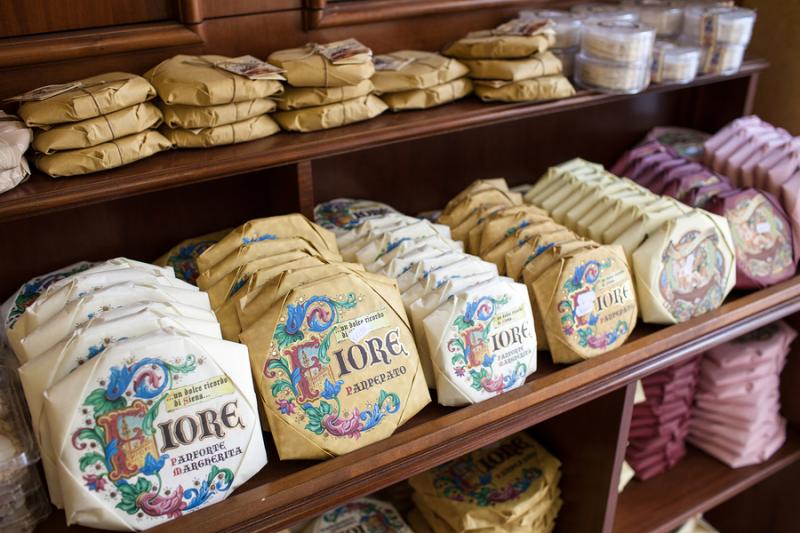Italian Christmas Cakes: Panforte
ITA:

Use player to listen to Italian version
Panforte is a typical Christmas cake from Siena, whose origins go back in time. A parchment attests to the existence of Panforte since at least 1205, but, in a simpler version, it originated even earlier, around the year 1000.
Originally, it was a honey-based focaccia and was called pan mielato (honey bread). Fruit was added later, but, during the warmer months, it fermented due to the heat; for this reason, the cake took on a more acidulous taste and the name turned into panforte. To avoid the fermentation of fresh fruit over time, some of the ingredients changed and panforte began to be prepared only on the coldest days, thus it became typical of the holiday season.
Originally, the preparation of panforte was entrusted to the ‘Art of the Doctors and Apothecaries of Siena’ and was intended exclusively for nobles and the clergy because it contained, in addition to almonds, candied orange, cedar and melon, what were very expensive spices for the time. The ingredients remained more or less the same until 1879, when Queen Margherita visited the city of Siena.
For the occasion, an apothecary prepared a panforte without candied melon and with a covering of vanilla sugar instead of black pepper. The Sienese offered it to the queen as ‘Panforte Margherita’, a more delicate version, and today, this white panforte is still known and marketed with this name.
Today, there are many variations of this Tuscan dessert, but the most famous are indeed the white version, and the black version, also called pan pepato.
Both recipes feature almonds, candied fruit and spices, but the black version differs for the addition of candied melon, the so-called ‘popone’ in Tuscan dialect, the use of sugar in place of honey, and the addition of sweet pepper to spices.
In 2013, Panforte di Siena obtained IGP certification (Protected Geographical Indication).
Il panforte è un tipico dolce natalizio senese, le cui origini risalgono ad un lontano passato. Una pergamena attesta l'esistenza del panforte sin dal 1205, ma, in una versione più semplice, questo dolce ebbe origine ancora prima, intorno all'anno 1000.
In origine era una focaccia a base di miele e si chiamava pan mielato. La frutta fu aggiunta più tardi, ma, durante i mesi più caldi, questa fermentava a causa del caldo; così, la preparazione prendeva un sapore più acidulo e allora il nome venne cambiato in panforte. Per evitare la fermentazione della frutta fresca, alcuni ingredienti cambiarono e il panforte iniziò a essere preparato solo nei giorni più freddi, diventando così tipico delle festività natalizie.
In origine, la preparazione del panforte era affidata all'Arte dei Medici e Speziali di Siena e il dolce era destinato esclusivamente ai nobili e al clero perché conteneva, oltre alle mandorle, all'arancia candita, al cedro e al melone, spezie che erano molto costose a quei tempi. Gli ingredienti rimasero più o meno invariati fino al 1879 quando la regina Margherita visitò la città di Siena.
Per l'occasione, un farmacista preparò un panforte senza melone candito e con una copertura di zucchero vanigliato al posto del pepe nero. Venne offerto alla regina come ‘Panforte Margherita’, una versione più delicata, e oggi questo panforte bianco è ancora conosciuto e commercializzato con questo nome.
Oggi ci sono molte varianti di questo dolce toscano, ma le più famose sono proprio la versione bianca, e la versione nera, chiamata anche pan pepato.
Entrambe le ricette includono mandorle, frutta candita e spezie, ma la versione nera si differenzia per l'aggiunta di melone candito, il cosiddetto ‘popone’ nel dialetto toscano, l'uso dello zucchero al posto del miele e l'aggiunta di pepe dolce alle spezie.
Nel 2013, il Panforte di Siena ha ottenuto la certificazione IGP.











